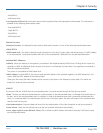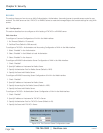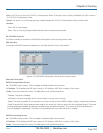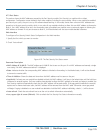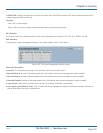
724-746-5500 | blackbox.com
Page 192
724-746-5500 | blackbox.com
Chapter 4: Security
• Aging Enabled: If checked, secured MAC addresses are subject to aging as discussed under Aging Period.
• Aging Period: If Aging Enabled is checked, then the aging period is controlled with this input. If other modules are using the
underlying port security for securing MAC addresses, they may have other requirements to the aging period. The underlying
port security will use the shorter requested aging period of all modules that use the functionality.
The Aging Period can be set to a number between 10 and 10,000,000 seconds.
To understand why aging may be desired, consider the following scenario: Suppose an end-host is connected to a third party
switch or hub, which in turn is connected to a port on this switch on which Limit Control is enabled. The end-host will be
allowed to forward if the limit is not exceeded. Now suppose that the end-host logs off or powers down. If it wasn’t for aging,
the end-host would still take up resources on this switch and will be allowed to forward. To overcome this situation, enable
aging. With aging enabled, a timer is started once the end-host gets secured. When the timer expires, the switch starts looking
for frames from the end-host, and if such frames are not seen within the next Aging Period, the end-host is assumed to be
disconnected, and the corresponding resources are freed on the switch.
Port Configuration
The table has one row for each port on the selected switch and a number of columns, which are:
• Port: The port number to which the configuration below applies.
• Mode: Controls whether Limit Control is enabled on this port. Both this and the Global Mode must be set to Enabled for Limit
Control to be in effect. Notice that other modules may still use the underlying port security features without enabling Limit
Control on a given port.
• Limit: The maximum number of MAC addresses that can be secured on this port. This number cannot exceed 1024. If the limit
is exceeded, the corresponding action is taken. The switch is “born“ with a total number of MAC addresses from which all
ports draw whenever a new MAC address is seen on a Port Security-enabled port. Since all ports draw from the same pool, it
may happen that a configured maximum cannot be granted, if the remaining ports have already used all available MAC
addresses.
• Action: If Limit is reached, the switch can take one of the following actions:
- None: Do not allow more than Limit MAC addresses on the port, but take no further action.
- Trap: If Limit + 1 MAC addresses is seen on the port, send an SNMP trap. If Aging is disabled, only one SNMP trap will be
sent, but with Aging enabled, new SNMP traps will be sent everytime the limit gets exceeded.
- Shutdown: If Limit + 1 MAC addresses is seen on the port, shut down the port. This implies that all secured MAC addresses
will be removed from the port, and no new address will be learned. Even if the link is physically disconnected and reconnected
on the port (by disconnecting the cable), the port will remain shut down. There are three ways to re-open the port:
1) Boot the switch,
2) Disable and re-enable Limit Control on the port or the switch,
3) Click the Reopen button.
- Trap and Shutdown: If Limit + 1 MAC addresses is seen on the port, both the “Trap“ and the “Shutdown“ actions described
above will be taken.
• State: This column shows the current state of the port as seen from the Limit Control’s point of view. The state takes one of
four values:
- Disabled: Limit Control is either globally disabled or disabled on the port.
- Ready: The limit is not yet reached. This can be shown for all actions.
- Limit Reached: Indicates that the limit is reached on this port. This state can only be shown if Action is set to None or Trap.
LGB1108A




